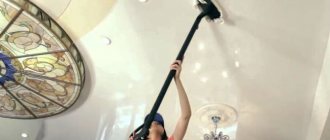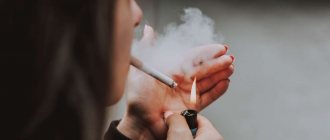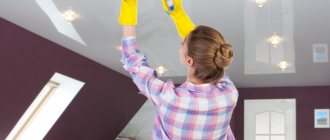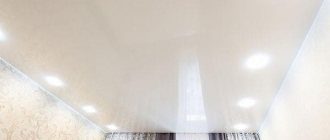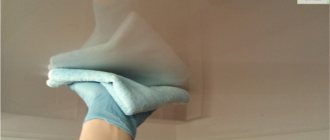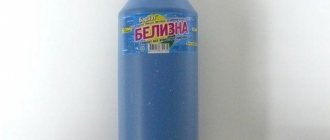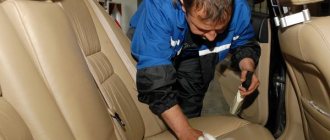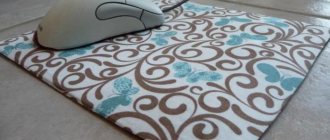Home / Baths
Anton
technical director NikoMax
No one is safe from flooding by neighbors above or from roof leaks. When such an unpleasant incident in every sense happens, the ceiling suffers first. The plaster and paint turn yellow with an unsightly stain, and the drywall swells. The situation is better with PVC stretch ceilings: water collects in it, like in a bubble, which can simply be drained and no special repairs need to be made. But with fabric ceilings everything is not so simple - they do not retain water.
How to clean a fabric stretch ceiling after a leak, and in general, what kind of care is needed for the fabric?
Why do stretch ceilings get dirty?
Stretch ceilings get dirty like any other covering. It doesn’t matter whether it’s matte or glossy. You may have noticed that:
- soot and grease stains are most often found in the kitchen due to the release of vapors or other substances during cooking, especially on a gas stove;
- white stains may appear in the bathroom due to evaporation of water or detergents;
- in children's rooms the surface may be stained with markers or paints;
- Regardless of the type of room, yellow nicotine traces appear on the ceilings if there is smoking in the room, as well as stains due to leaks.
In addition, splashes of champagne may fall on the ceiling when opening the bottle, as well as drops of brine, compote and other products if the container explodes. Also, do not forget that dust settles on the ceiling over time.
The nature of cleaning suspended ceilings depends on the complexity of the contamination. If it is dust, you can simply wipe the surface with a dry sponge or cloth. Clean greasy and stubborn stains only with cold or slightly warm water and special products that will not harm the film.
Regularity of washing
Stretch ceilings do not require weekly maintenance; they need to be washed when they become dirty. In the kitchen, washing is done more often than in the living room or bedroom. This is due to the fact that fat and fumes from cooking settle on all surfaces, even if the ceilings are quite high.
Various stains appear more often in the kitchen - an unsuccessful opening of a can or bottle, a strong swing of a spoon or spatula with remnants of sauce, food, which as a result ends up on the ceiling.
Important! Kitchen surfaces need wet cleaning, and usually matte or glossy stretch ceilings are installed there (fabric ones are absolutely not suitable for this area).
In other rooms, the main type of pollution is dust. Cobwebs appear a little less frequently. Glossy ceilings require more frequent maintenance than matte ones. They require regular polishing, as the shiny surface can become dull over time.
How can you wash suspended ceilings?
If for some reason it was not possible to wash the canvas with a dry or damp cloth, try cleaning the surface with a window cleaner containing ammonia. Choose a substance without dyes. Please note that only ceilings made of PVC film can be cleaned with this product; fabric ceilings are not recommended. The substance is easy to apply, removes various types of stains well and does not leave streaks.
If there are stains on the ceiling surface from construction or renovation, a melamine sponge will be an excellent helper. Please note that this device can only be used on matte and satin ceilings.
If you want to clean the surface and remove bacteria from the surface using a steam cleaner, then this is not a suitable option. The fact is that stretch ceilings can withstand low temperature thresholds. PVC film - no more than 50 degrees, and fabric - a maximum of 80 degrees. Considering that the device supplies steam at the boiling point level, namely 100 degrees, their use for washing can end tragically. The ceiling will become deformed, sag and may melt.
What tools are needed for washing
Before cleaning the stretch ceiling, prepare the necessary tools:
- mop with a soft attachment;
- several rags made of soft fabric;
- sponges;
- bucket or basin for water;
- stool or stepladder.
An excellent option would be a mop with a telescopic handle and a rotating platform with a removable cloth.
What cleaning products can you use?
The safest and most effective product is laundry or liquid soap. It successfully combats various types of contaminants and does not harm the surface.
An alternative to soap is dishwashing detergent. It copes well with greasy stains and plaque. You can also use washing powder, but only in foam form.
In addition, you can use window cleaners with ammonia or simply dilute ammonia in water - the effect will be the same.
Specialized stores sell products designed for cleaning suspended ceilings. Created using original technology, the substance without caustic alkalis and acids in the composition carefully cleans the surface and does not have a harmful effect on the skin of the hands. However, purchasing such a product will cost many times more than available methods. It’s better to first try to clean the surface using conventional means, and use special ones only in difficult cases.
What is not recommended to use
Stretch ceilings are a delicate product, easily deteriorate from strong mechanical influences and caustic substances, and are susceptible to high temperatures. To clean the surface, do not use:
- hard sponges and brushes;
- abrasives: powders and soda;
- substances containing acetone;
- acidic and alkaline substances, bleach or mustard;
- hot water.
During the procedure, remove all jewelry from your hands (rings, bracelets, watches) so as not to damage the integrity of the coating. Make all movements carefully, without strong pressure.
General rules
You need to care for stretch ceilings in the same way as regular ceilings: brush off dust, remove cobwebs, and remove any dirt that has appeared. But due to the antistatic coating, these manipulations are carried out once every 5-7 years or as they become dirty. In any case, before cleaning, you must remove all decorations that could scratch the surface of the stretch ceiling. Also, do not use abrasive and caustic detergents or hard-bristled brushes. This may negatively affect the aesthetic appearance of the canvas. The best detergent is plain water with soap and microfiber. But, if there is no effect, only then use the “heavy artillery” sponge and detergents that do not contain chlorine. In any case, before using this or that product, you need to test it on a piece of fabric that remains after installing the stretch ceiling.
Dust on the ceiling
Remove dust using a vacuum cleaner with a soft attachment. The power needs to be reduced so that the fabric is not attracted to the tube of the unit; the cobwebs are also removed; it is not recommended to remove them with a broom, because you can accidentally rub it into the top layer of the fabric and dark stains will remain.
Stains on the tensioner
As already mentioned, first we try to remove it with a soft cloth soaked in water. If that doesn’t work, we use a special product for caring for stretch ceilings. If you don’t have any at hand, try “folk” methods. Dilute a little dishwashing detergent or regular soap in water. This will help remove fingerprints or other minor stains.
If the stains are more serious, try an alcohol solution. It is necessary to dilute 1 part of ammonia 10% in 9 parts of water, moisten the sponge and methodically wipe off the dirty mark. Usually this is quite enough. After washing, the ceiling is wiped clean with a clean damp cloth, and then dried with a dry cloth. The material should be chosen without lint, such as microfiber, so that no unnecessary elements remain on the ceiling.
How to wash a glossy ceiling without streaks
To wash a glossy surface and leave it streak-free, follow a certain sequence of actions and do not use aggressive or abrasive substances.
Fabric preparation
First of all, prepare the canvas for the procedure. Place a stool or stepladder so that the movements are made comfortably, otherwise you will quickly get tired. Also prepare tools and cleaning supplies and place them nearby. Remove all jewelry from your hands and put on gloves. Prepare the water in advance, making sure it is not too hot, ideally 30–40 degrees.
Test your chosen cleaning method on a small, inconspicuous area of the surface. Carry out all the necessary procedures with this area and wait 10–15 minutes. If the material has not been deformed and its color has not changed, the chosen method is suitable.
To remove dust and cobwebs, carefully vacuum the ceiling before starting work, barely touching the surface. Set the device to the lowest power. To avoid damaging the coating, wrap the vacuum cleaner brush with a thin towel. Please note that if you feel that the vacuum cleaner is dragging too much, do not touch the surface at all, keep the vacuum cleaner brush at a distance of 10–15 cm from the ceiling.
Surface washing
Clean the canvas in a certain sequence:
- Carefully examine the canvas, look for stains and spot contamination.
- Dissolve laundry soap or detergent in water and soak a rag in the solution.
- Rub the stains gently, without applying too much pressure. Repeat the manipulation until they disappear.
- If you are using a mop, keep the handle at a 45-degree angle while mopping. This way you will avoid getting splashed on yourself.
- Resourceful housewives use a spray bottle to clean complex stains. A soap solution is poured into it, which is sprayed on the surface and wiped with a rag.
- After treating the area, rinse the soap solution thoroughly with clean warm water and wipe dry to avoid streaks.
- Inspect the canvas again to make sure you have removed all the stains.
Final processing
When the main work is completed, the final processing of the ceiling is carried out. For the procedure you will need ammonia or ethyl alcohol and water.
Dilute 1 part alcohol to 10 parts water and apply to a dry cloth. Use it to treat the entire surface. Such actions will help get rid of stains and give the stretch ceiling shine.
Possible mistakes when washing a glossy ceiling
To avoid having to redo the work, remember what actions it is better not to perform:
- try not to make circular movements, as this kind of action will leave streaks;
- if the fabric consists of several parts, rub along, not across the seam;
- do not clean too often, as the structure of the film may be damaged and the shiny coating may become dull;
- Work before noon, in clear weather, to notice even minor dirt.
Method of washing fabric covering
The peculiarity of this interior element is that it does not tolerate a very wide range of cleaning agents. For example, some of the mentioned methods cannot be applied to it, in particular washing with glass solutions, which eat into the structure of the fabric, subsequently changing its color due to coloring additives. In addition, such a surface does not tolerate circular movements when wiped with a cloth. The result of careless handling is noticeable stains, and they are incredibly difficult to get rid of.
Experts advise using water with the addition of washing powder/ammonia/soap/dishing detergent, removing heavy dirt with direct movements. By the way, such a ceiling is not afraid of abrasives, and this is its advantage. You can also carefully vacuum it, getting rid of cobwebs, which is strictly prohibited in relation to film products.
Cleaning contaminants in various rooms
Take care in advance about the tools and equipment that are required in each specific case. Their type, variety and quantity, as well as the complexity of the work are determined by the type of room in which the ceilings are washed.
- If this is a living room, children's room or bedroom, it is enough to wipe the surface with a dry soft sponge every six months or vacuum the ceiling once every 2-3 months.
- In the kitchen, ceilings usually get dirty the fastest. At the same time, the most persistent contaminants appear on the surface. You will have to wash the canvas as it becomes dirty at least once every 1–2 months; extreme attention will need to be paid to the area above the stove. To make cleaning easier, cover pots with lids when cooking and do not allow grease to get onto the ceiling. Carry out the treatment with special products that can quickly remove greasy marks.
- The suspended ceiling in the bathroom is constantly exposed to steam and condensation accumulation. To prevent this, ventilate the room and sometimes check the plumbing. If the canvas gets splashed or condensation collects, remove the moisture with a dry cloth. Carry out a thorough cleaning once every 2 months using a glass cleaner.
- On the loggia, surfaces quickly become covered with dust or insect excrement. Cleaning ceilings, especially in the summer, is required quite often. Wash the canvas with soapy water, rinse and dry with a dry cloth. After the procedure, wipe the surface with an alcohol solution.
Properties and Features
Before you start cleaning the ceiling covering, you need to familiarize yourself with its characteristics:
- made from fabric impregnated with a chemical substance - polyurethane;
- has micropores that allow air to pass through;
- quite durable but inelastic material;
- environmentally friendly, free of foreign odors;
- When flooded, it can retain moisture for some time. Moisture seeps through micropores over time. It is necessary to call specialists as soon as possible and remove the fabric to dry;
- does not withstand heavy loads - do not test the strength of the canvas. Under heavy mechanical load, the fabric may slip out of the fastening;
- may be subject to mechanical damage - when cleaning, do not use hard brushes or other tools that can damage the material;
- Maintenance of fabric stretch ceilings is carried out independently and this happens without much difficulty.
Also read: Caring for suspended ceilings.
How to remove stains from ceilings
The complexity of cleaning primarily depends on the nature of the contamination.
In the kitchen from soot and grease
The best way to remove greasy stains and soot on the surface is with dishwashing detergent. Dissolve the substance in water and gently apply to the problem area. Wait a little and wash off any remaining dirt with warm water.
From nicotine
If your ceiling has nasty nicotine stains, use glass cleaner or dishwashing detergent. Apply the substance to the dirt and wait a little, then rinse off the remaining soap with warm water and wipe the surface with a dry cloth.
From dust
To clean the suspended ceiling from dust, use dry cleaning. Simply wipe the canvas with a dry sponge or rag. Your movements should be light and you should not press on the surface. You can also dry clean using a vacuum cleaner.
From yellow spots
If yellow stains from leaks appear on the surface, ammonia or a glass cleaner based on it will help remove the marks.
From paint
First of all, pay attention to what kind of paint got on the ceiling. Fresh water-based emulsion is cleaned with a wet cloth, acrylic paint - only with a special means for cleaning stretch fabrics. If drops of more durable paints get on the surface, do not take risks and contact a cleaning company for help.
From primer
After repairs, traces of primer may remain on the ceiling. Such stains can be easily removed with a damp cloth soaked in a soapy solution made from laundry or liquid soap.
Household chemicals
If the stain cannot be removed with a damp cloth, it is best to treat the coating with a special detergent . Using a suspended ceiling cleaner, which comes in the form of a spray, gel or solution, in accordance with the instructions, you can be sure that you will not spoil the material. A fresh stain can be easily removed using special wet wipes.
Carefully! Never use detergents containing abrasives or bleach. Household chemicals containing acid, alkali or acetone can also damage the material.
For those who do not consider it necessary to buy an expensive detergent, the following may be useful:
- washing powder without bleach;
- laundry soap;
- dishwashing liquid;
- glass and mirror cleaner;
- ammonia;
- White Spirit.
To obtain a soap solution, carefully dilute washing powder or laundry soap shavings in warm water.
How to care for a suspended ceiling
To keep the ceiling always sparkling clean:
- Dry clean with a sponge or vacuum cleaner from time to time.
- Remove stains immediately after they appear, before the stains are absorbed into the structure of the material.
- Regularly ventilate all rooms in the apartment to avoid excessive humidity.
- In the kitchen, when cooking, be sure to turn on the hood and cover pots and pans with lids.
Cleaning a suspended ceiling is easy. The main thing is to follow simple cleaning rules and not to use prohibited substances and tools. To minimize your cleaning time, dry-clean the surface from time to time and remove stains as soon as they appear.
What should you not do?
- Do not use aggressive abrasive detergents. Such products will leave scratches on the surface of the ceiling, which will completely ruin the appearance.
- You should not use a mop to clean the stretch ceiling. You can simply tear the surface with it. Use a stepladder.
- The faster you clean the stain after it is discovered, the better your chances. That there will be no traces left.
How to clean a stretch ceiling from stains so that it becomes a perfectly even color? Methods proven by many housewives will help.
The main reasons for the appearance of yellow spots on the ceiling
There are practically two reasons for the appearance of yellow spots on the ceiling. The most common sources of this negative phenomenon are excess moisture or poor quality material used in repairs, as well as violations of technology during repairs. The most obvious sign of “excessive” moisture is flooding (neighbors above have flooded, the roof of the house is leaking, heating pipes or water supply pipes have burst when they are installed at the top, etc.). However, the source of yellow spots can also be the lack of sufficient ventilation in the apartment. In such a situation, water vapor in the form of condensation will settle on the ceiling, which can lead not only to the formation of stains, but also cause the appearance of various types of fungal colonies, including the most dangerous variety for human health - black mold.
If the ceiling remains damp for a long time, this can lead to corrosion of the reinforcement in the concrete floor slabs and the appearance of rust stains on the ceiling, which are very difficult to remove, since this requires destroying the concrete, getting to the reinforcement and carrying out anti-corrosion treatment on it, then is to eliminate the source of rust. And this is a rather labor-intensive and costly process.
In some cases, the reason for the appearance of yellow spots on the ceiling may be poor-quality materials used in renovating the apartment, or a violation of the technology during the renovation (the oil paint coating was not completely removed, the ceiling was not primed and treated with antiseptics, etc.). In this case, it will be necessary to eliminate the mistakes and miscalculations made during the repair. However, before deciding how to remove yellow stains on the ceiling, you must first determine the reasons for their appearance, since cosmetic camouflage can hide them for a very short time and over time the stains will appear again in all their “glory.”
Ammonia
The product is diluted in water (1 teaspoon per liter of liquid), treated with it, and washed off. But here you need to take care of protection, use rubber gloves and a respirator.
The effect depends not only on the product chosen, but also on how competently the cleaning is carried out. First of all, you need to prepare a stable stepladder and everything you need for washing. After that, you can start working, and to finish everything off, it is recommended to rub the surface (especially glossy) with a soft, lint-free cloth.
- Author: Natalya32
Rate this article:
- 5
- 4
- 3
- 2
- 1
(0 votes, average: 0 out of 5)
Share with your friends!
Wiper
The product removes grease stains from the surfaces of PVC ceilings, but it is not advisable to use it for fabric structures (even more noticeable stains may appear, loss of color and other undesirable effects). The product is sprayed onto the contaminated area and rubbed with a soft cloth. In this case, you need to be careful; too intense movements can damage the surface (this is especially true for matte ceilings).
How to remove stains from the ceiling after a flood
If there is flooding in the apartment (the neighbor above flooded or the roof leaked), there are two possible solutions to the problem.
1st option: there was a slight leak of water, and the ceiling got wet in a small area. In this case, after the streaks have dried, you can try to remove the stains that have appeared with chlorine-containing preparations.
2nd option: due to heavy flooding, the ceiling got wet over a significant area, which even resulted in the peeling of the putty from the floor slabs. Any cosmetic measures will not help here. It will be necessary to completely scrape off all the putty mechanically, prime the ceiling and putty it again, that is, carry out a full repair.
Professional store products
EdelWeiss
How to clean a suspended ceiling without spoiling its appearance? This is a modern cleaning product designed specifically for stretch fabrics. It is packaged in ergonomic bottles that have a spray nozzle, which makes cleaning extremely easy, since you often have to wipe the surface in uncomfortable conditions from a table or stepladder. It is notable for its gentle but effective composition: it contains neither alkalis nor caustic acids, and is safe for both delicate materials and sensitive skin of the hands. Despite such a gentle influence, it copes with dirt perfectly.
Nouvelle
Another popular professional aerosol product designed for ceiling coverings. Harmless and powerful, it removes soap smudges in the bathroom, grease with settled soot, ingrained traces of insects, and dusty stains. The bottle of this universal product is convenient to hold in your hands while cleaning, which is also a huge plus.
Mister Muscle
It perfectly removes dirt on stretch fabrics, including settled fumes from cooking food. Removes any specific kitchen stains without leaving any unsightly marks. It has a non-toxic and non-aggressive effect, making it suitable for all cases.
LOC from Amway
A universal remedy that is loved by many owners. Helps to easily and quickly clean delicate surfaces, even glossy textures, because it does not create streaks and gives the materials a special freshness and shine. Suitable for those who care about their home and do not want unnecessary problems. It may not be worth overpaying, but this is the price of comfortable cleaning and high-quality results.
Kare Noir
An innovative, well-known product that copes with a wide range of contaminants. You can trust him with stretch fabric that needs gentle and effective cleaning.
Other branded products
You can use special compounds recommended by the manufacturer specifically for your ceiling. Who else but the manufacturer knows what exactly is suitable for the surface he creates? If it is not possible to do this, choose any similar product sold in a household chemical store. Just keep the following conditions in mind:

